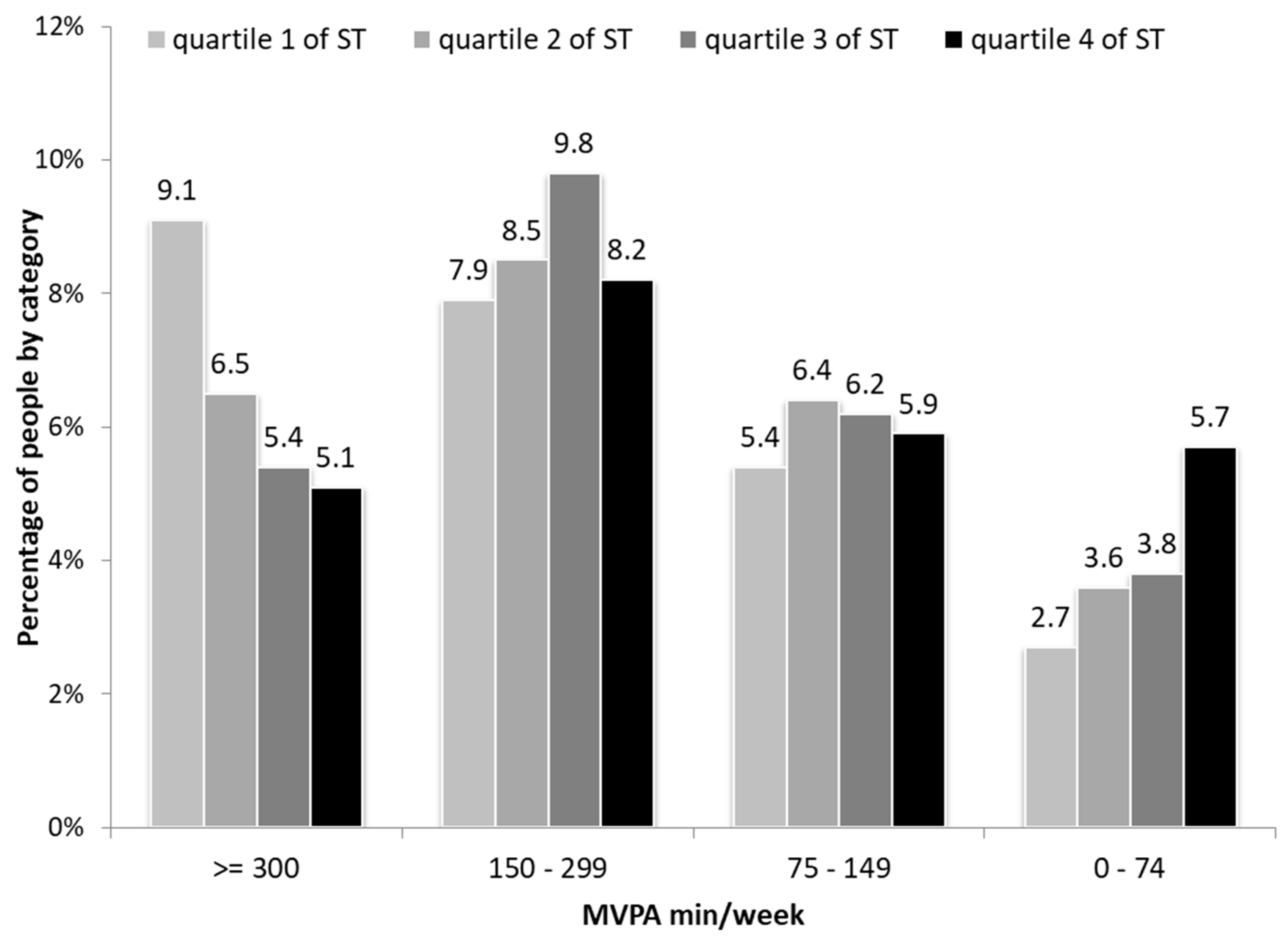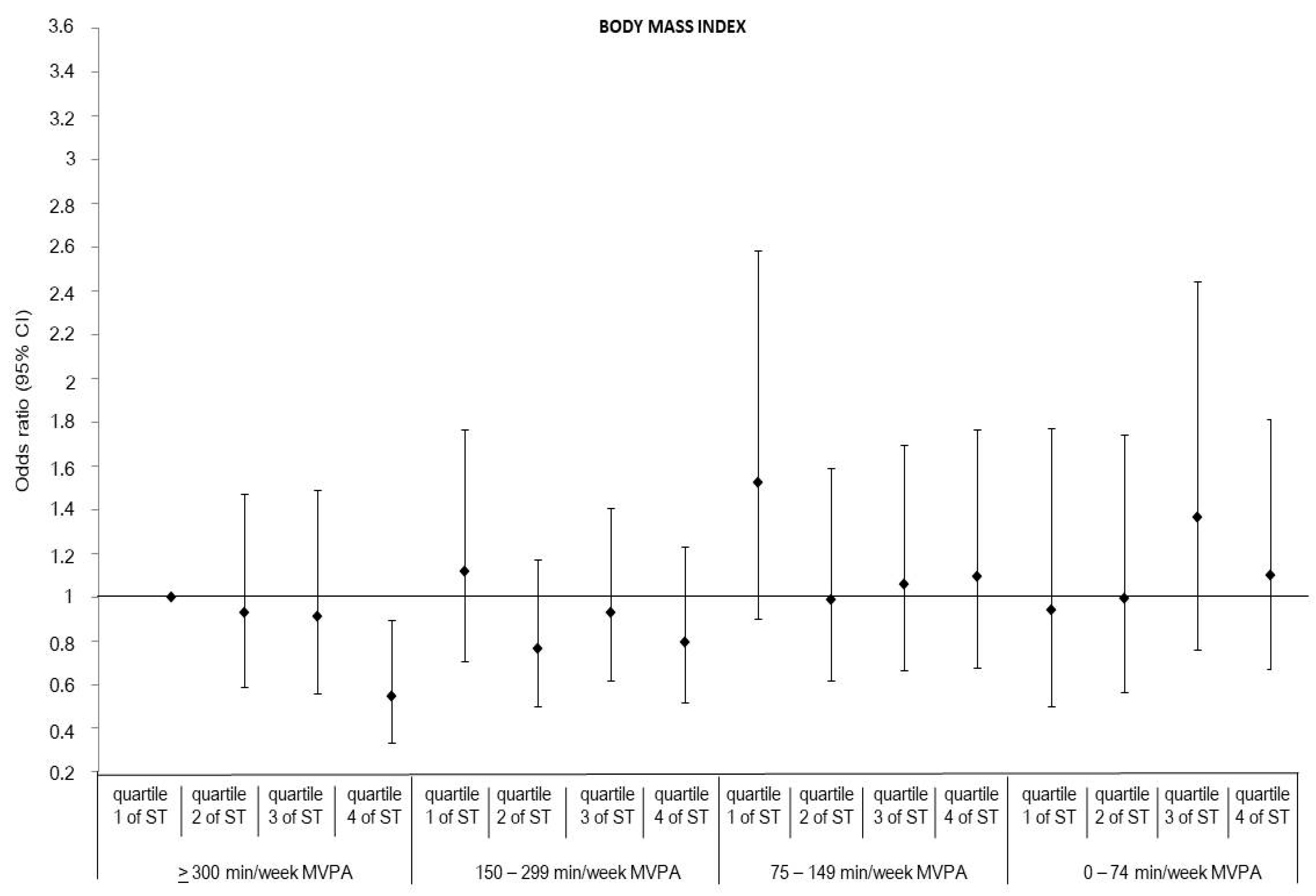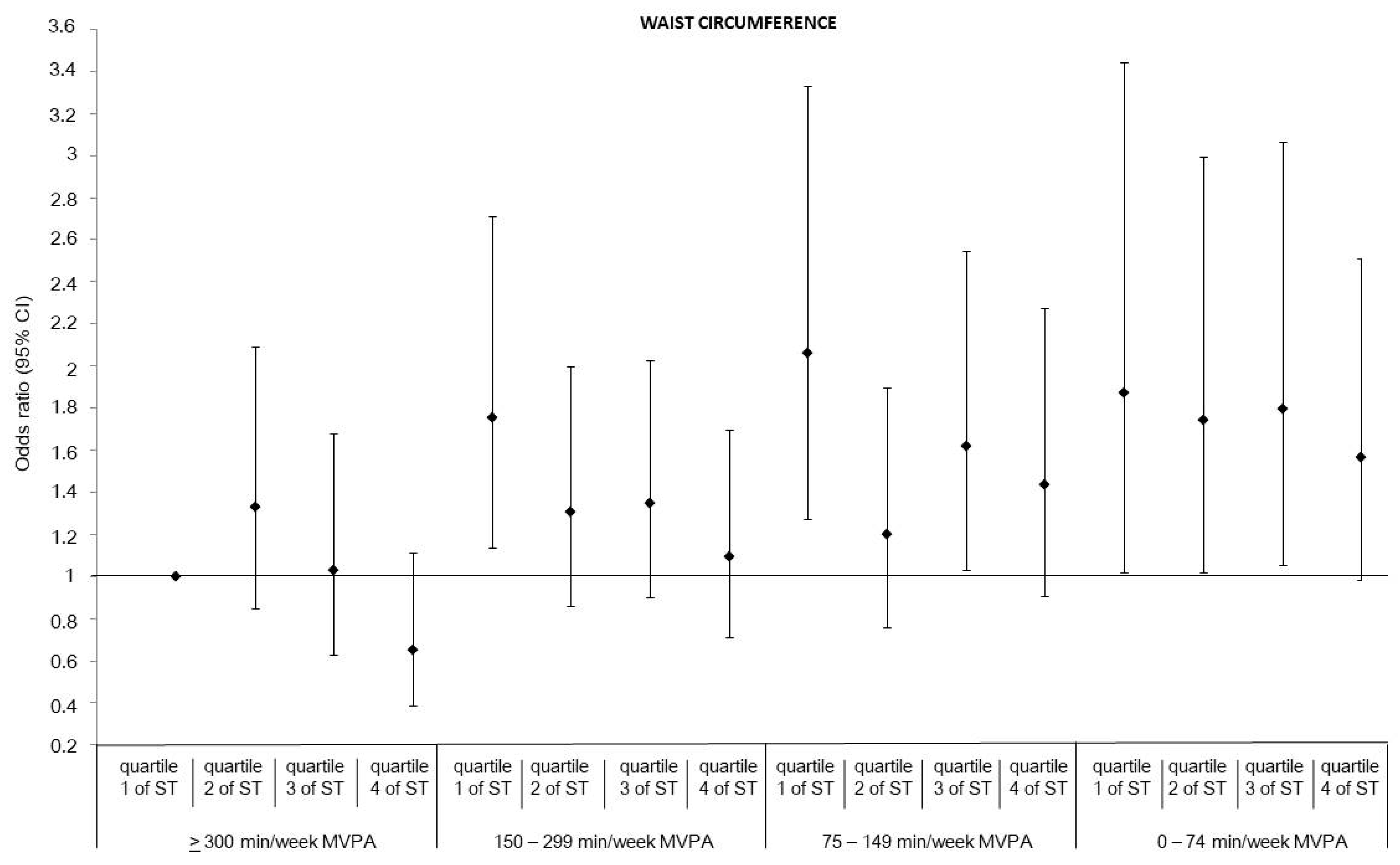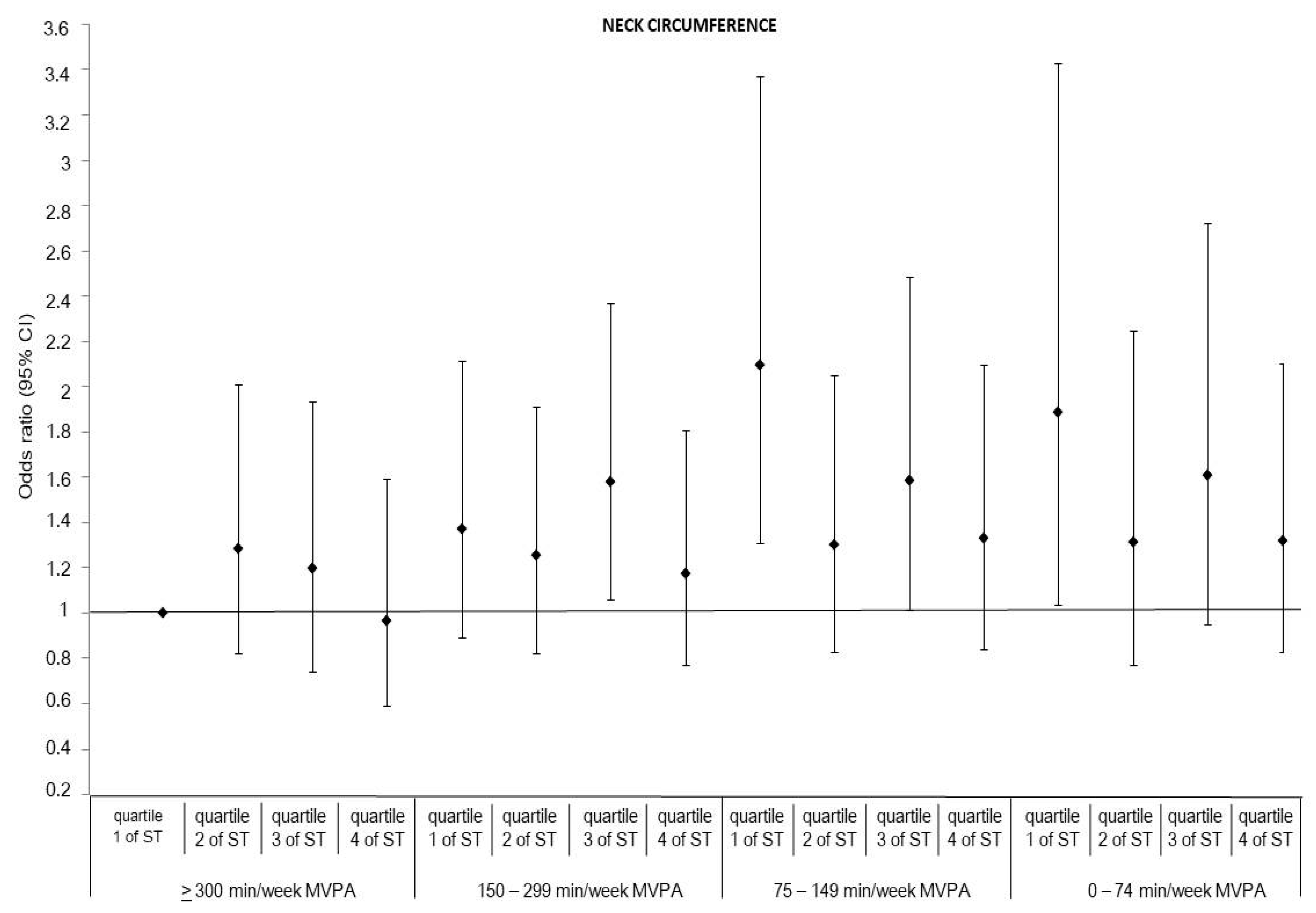Joint Association between Sedentary Time and Moderate-to-Vigorous Physical Activity with Obesity Risk in Adults from Latin America
Abstract
1. Introduction
2. Materials and Methods
2.1. Study Design and Sample
2.2. Data Collection Procedure
2.3. Sedentary Time and Moderate-to-Vigorous Physical Activity
2.4. Obesity Risk
2.5. Sociodemographic Variables
2.6. Statistical Analysis
3. Results
4. Discussion
5. Conclusions
Author Contributions
Funding
Institutional Review Board Statement
Informed Consent Statement
Data Availability Statement
Acknowledgments
Conflicts of Interest
References
- Warburton, D.E.R.; Bredin, S.S.D. Health Benefits of Physical Activity: A Strengths-Based Approach. J. Clin. Med. 2019, 8, 2044. [Google Scholar] [CrossRef] [PubMed]
- Jakicic, J.M.; Powell, K.E.; Campbell, W.W.; Dipietro, L.; Pate, R.R.; Pescatello, L.S.; Collins, K.A.; Bloodgood, B.; Piercy, K.L. Physical Activity and the Prevention of Weight Gain in Adults: A Systematic Review. Med. Sci. Sports Exerc. 2019, 51, 1262–1269. [Google Scholar] [CrossRef] [PubMed]
- Wang, Y.; Nie, J.; Ferrari, G.; Rey-Lopez, J.P.; Rezende, L.F.M. Association of Physical Activity Intensity with Mortality: A National Cohort Study of 403681 US Adults. JAMA Intern. Med. 2021, 181, 203–211. [Google Scholar] [CrossRef] [PubMed]
- Bull, F.C.; Al-Ansari, S.S.; Biddle, S.; Borodulin, K.; Buman, M.P.; Cardon, G.; Carty, C.; Chaput, J.-P.; Chastin, S.; Chou, R.; et al. World Health Organization 2020 guidelines on physical activity and sedentary behaviour. Br. J. Sports Med. 2020, 54, 1451–1462. [Google Scholar] [CrossRef]
- Ferrari, G.; Werneck, A.O.; da Silva, D.R.; Kovalskys, I.; Gómez, G.; Rigotti, A.; Sanabria, L.Y.C.; García, M.Y.; Pareja, R.G.; Herrera-Cuenca, M.; et al. Is the perceived neighborhood built environment associated with domain-specific physical activity in Latin American adults? An eight-country observational study. Int. J. Behav. Nutr. Phys. Act. 2020, 17, 125. [Google Scholar] [CrossRef]
- Werneck, A.O.; Sadarangani, K.P.; Ramírez-Vélez, R.; Baldew, S.-S.; Gomes, T.N.; Ferrari, G.; Szwarcwald, C.L.; Miranda, J.J.; Silva, D.R. Macroeconomic, demographic and human developmental correlates of physical activity and sitting time among South American adults. Int. J. Behav. Nutr. Phys. Act. 2020, 17, 163. [Google Scholar] [CrossRef]
- Ferrari, G.L.D.M.; Kovalskys, I.; Fisberg, M.; Gómez, G.; Rigotti, A.; Sanabria, L.Y.C.; García, M.C.Y.; Torres, R.G.P.; Herrera-Cuenca, M.; Zimberg, I.Z.; et al. Socio-demographic patterning of objectively measured physical activity and sedentary behaviours in eight Latin American countries: Findings from the ELANS study. Eur. J. Sport Sci. 2020, 20, 670–681. [Google Scholar] [CrossRef]
- Thivel, D.; Tremblay, A.; Genin, P.M.; Panahi, S.; Rivière, D.; Duclos, M. Physical Activity, Inactivity, and Sedentary Behaviors: Definitions and Implications in Occupational Health. Front. Public Health 2018, 6, 288. [Google Scholar] [CrossRef]
- Ferrari, G.; Werneck, A.O.; Silva, D.R.; Kovalskys, I.; Gómez, G.; Rigotti, A.; Cortés, L.Y.; García, M.Y.; Liria, M.; Herrera-Cuenca, M.; et al. Agreement Between Self-Reported and Device-Based Sedentary Time among Eight Countries: Findings from the ELANS. Prev. Sci. 2021, 22, 1036–1047. [Google Scholar] [CrossRef]
- Tremblay, M.S.; Aubert, S.; Barnes, J.D.; Saunders, T.J.; Carson, V.; Latimer-Cheung, A.E.; Chastin, S.F. Sedentary behavior research network (SBRN)–terminology consensus project process and outcome. Int. J. Behav. Nutr. Phys. Act. 2017, 14, 75. [Google Scholar] [CrossRef]
- Rezende, L.F.; Lee, D.H.; Ferrari, G.; Giovannucci, E. Confounding due to pre-existing diseases in epidemiologic studies on sedentary behavior and all-cause mortality: A meta-epidemiologic study. Ann. Epidemiol. 2020, 52, 7–14. [Google Scholar] [CrossRef] [PubMed]
- WHO. WHO Guidelines on Physical Activity and Sedentary Behaviour; World Health Organization: Geneva, Switzerland, 2020. [Google Scholar]
- Stamatakis, E.; Ekelund, U.; Ding, D.; Hamer, M.; E Bauman, A.; Lee, I.-M. Is the time right for quantitative public health guidelines on sitting? A narrative review of sedentary behaviour research paradigms and findings. Br. J. Sports Med. 2019, 53, 377–382. [Google Scholar] [CrossRef] [PubMed]
- Kovalskys, I.; Fisberg, M.; Gómez, G.; Pareja, R.G.; García, M.C.Y.; Sanabria, L.Y.C.; Herrera-Cuenca, M.; Rigotti, A.; Guajardo, V.; Zimberg, I.Z.; et al. Energy intake and food sources of eight Latin American countries: Results from the Latin American Study of Nutrition and Health (ELANS). Public Health Nutr. 2018, 21, 2535–2547. [Google Scholar] [CrossRef] [PubMed]
- Guthold, R.; Stevens, G.A.; Riley, L.M.; Bull, F.C. Worldwide trends in insufficient physical activity from 2001 to 2016: A pooled analysis of 358 population-based surveys with 1.9 million participants. Lancet Glob. Health 2018, 6, e1077–e1086. [Google Scholar] [CrossRef]
- Ferrari, G.; Werneck, A.O.; Silva, D.R.; Kovalskys, I.; Gómez, G.; Rigotti, A.; Cortés, L.Y.; García, M.C.Y.; Liria-Domínguez, M.R.; Herrera-Cuenca, M.; et al. Perceived Urban Environment Attributes and Device-Measured Physical Activity in Latin America: An 8-Nation Study. Am. J. Prev. Med. 2022, 62, 635–645. [Google Scholar] [CrossRef]
- Gonze, B.D.B.; Ostolin, T.L.V.D.P.; Sperandio, E.F.; Arantes, R.L.; Romiti, M.; Dourado, V.Z. Effects of Substituting Sedentary Behavior with Light-Intensity or Moderate-to-Vigorous Physical Activity on Obesity Indices in Adults: A Prospective Short-Term Follow-Up Study. Int. J. Environ. Res. Public Health 2021, 18, 13335. [Google Scholar] [CrossRef]
- Van Dyck, D.; Cerin, E.; De Bourdeaudhuij, I.; Hinckson, E.; Reis, R.S.; Davey, R.; Sarmiento, O.L.; Mitas, J.; Troelsen, J.; MacFarlane, D.; et al. International study of objectively measured physical activity and sedentary time with body mass index and obesity: IPEN adult study. Int. J. Obes. 2015, 39, 199–207. [Google Scholar] [CrossRef]
- DiPietro, L.; Al-Ansari, S.S.; Biddle, S.J.; Borodulin, K.; Bull, F.C.; Buman, M.P.; Cardon, G.; Carty, C.; Chaput, J.P.; Chastin, S.; et al. Advancing the global physical activity agenda: Recommendations for future research by the 2020 WHO physical activity and sedentary behavior guidelines development group. Int. J. Behav. Nutr. Phys. Act. 2020, 17, 143. [Google Scholar] [CrossRef]
- Fisberg, M.; The ELANS Study Group; Kovalskys, I.; Gómez, G.; Rigotti, A.; Cortés, L.Y.; Herrera-Cuenca, M.; Yépez, M.C.; Pareja, R.G.; Guajardo, V.; et al. Latin American Study of Nutrition and Health (ELANS): Rationale and study design. BMC Public Health 2015, 16, 93. [Google Scholar] [CrossRef]
- Ferrari, G.L.D.M.; Kovalskys, I.; Fisberg, M.; Gómez, G.; Rigotti, A.; Sanabria, L.Y.C.; García, M.C.Y.; Torres, R.G.P.; Herrera-Cuenca, M.; Zimberg, I.Z.; et al. Methodological design for the assessment of physical activity and sedentary time in eight Latin American countries—The ELANS study. Methodsx 2020, 7, 100843. [Google Scholar] [CrossRef]
- Freedson, P.S.; Melanson, E.; Sirard, J. Calibration of the Computer Science and Applications, Inc. accelerometer. Med. Sci. Sports Exerc. 1998, 30, 777–781. [Google Scholar] [CrossRef] [PubMed]
- Freedson, P.S.; Miller, K. Objective monitoring of physical activity using motion sensors and heart rate. Res. Q. Exerc. Sport 2000, 71, 21–29. [Google Scholar] [CrossRef]
- Yano, S.; Koohsari, M.J.; Shibata, A.; Ishii, K.; Frehlich, L.; McCormack, G.R.; Oka, K. Physical Activity and Sedentary Behavior Assessment: A Laboratory-Based Evaluation of Agreement between Commonly Used ActiGraph and Omron Accelerometers. Int. J. Environ. Res. Public Health 2019, 16, 3126. [Google Scholar] [CrossRef] [PubMed]
- Colley, R.; Gorber, S.C.; Tremblay, M.S. Quality control and data reduction procedures for accelerometry-derived measures of physical activity. Health Rep. 2010, 21, 63–69. [Google Scholar]
- Troiano, R.P.; Berrigan, D.; Dodd, K.W.; Masse, L.C.; Tilert, T.; McDowell, M. Physical activity in the United States measured by accelerometer. Med. Sci. Sport. Exerc. 2008, 40, 181–188. [Google Scholar] [CrossRef]
- Brønd, J.C.; Arvidsson, D. Sampling frequency affects the processing of Actigraph raw acceleration data to activity counts. J. Appl. Physiol. 2016, 120, 362–369. [Google Scholar] [CrossRef] [PubMed]
- Matthews, C.E.; Chen, K.Y.; Freedson, P.S.; Buchowski, M.S.; Beech, B.M.; Pate, R.R.; Troiano, R.P. Amount of Time Spent in Sedentary Behaviors in the United States, 2003–2004. Am. J. Epidemiol. 2008, 167, 875–881. [Google Scholar] [CrossRef] [PubMed]
- Young, D.R.; Hivert, M.-F.; Alhassan, S.; Camhi, S.M.; Ferguson, J.F.; Katzmarzyk, P.T.; Lewis, C.E.; Owen, N.; Perry, C.K.; Siddique, J.; et al. Sedentary Behavior and Cardiovascular Morbidity and Mortality: A Science Advisory From the American Heart Association. Circulation 2016, 134, e262–e279. [Google Scholar] [CrossRef]
- Stamatakis, E.; Gale, J.; Bauman, A.; Ekelund, U.; Hamer, M.; Ding, D. Sitting Time, Physical Activity, and Risk of Mortality in Adults. J. Am. Coll. Cardiol. 2019, 73, 2062–2072. [Google Scholar] [CrossRef]
- Van der Ploeg, H.P.; Chey, T.; Korda, R.J.; Banks, E.; Bauman, A. Sitting time and all-cause mortality risk in 222,497 Australian adults. Arch. Intern. Med. 2012, 172, 494–500. [Google Scholar] [CrossRef]
- Lohman, T.J.; Roache, A.F.; Martorell, R. Anthropometric Standardization Reference Manual; Human Kinetics Books: Champaign, IL, USA, 1988; Volume 6, p. 177. [Google Scholar]
- WHO. Obesity: Preventing and Managing the Global Epidemic; Technical Report Series; WHO: Geneva, Switzerland, 1998; p. 894. [Google Scholar]
- Aschner, P.; Buendía, R.; Brajkovich, I.; Gonzalez, A.; Figueredo, R.; Juarez, X.E.; Uriza, F.; Gomez, A.M.; Ponte, C.I. Determination of the cutoff point for waist circumference that establishes the presence of abdominal obesity in Latin American men and women. Diabetes Res. Clin. Pr. 2011, 93, 243–247. [Google Scholar] [CrossRef]
- Cornier, M.A.; Després, J.P.; Davis, N.; Grossniklaus, D.A.; Klein, S.; Lamarche, B.; Lopez-Jimenez, F.; Rao, G.; St-Onge, M.P.; Towfighi, A.; et al. Assessing adiposity: A scientific statement from the American Heart Association. Circulation 2011, 124, 1996–2019. [Google Scholar] [CrossRef] [PubMed]
- Onat, A.; Hergenç, G.; Yüksel, H.; Can, G.; Ayhan, E.; Kaya, Z.; Dursunoğlu, D. Neck circumference as a measure of central obesity: Associations with metabolic syndrome and obstructive sleep apnea syndrome beyond waist circumference. Clin. Nutr. 2009, 28, 46–51. [Google Scholar] [CrossRef]
- Cleven, L.; Krell-Roesch, J.; Nigg, C.R.; Woll, A. The association between physical activity with incident obesity, coronary heart disease, diabetes and hypertension in adults: A systematic review of longitudinal studies published after 2012. BMC Public Health 2020, 20, 726. [Google Scholar] [CrossRef] [PubMed]
- Swift, D.L.; Johannsen, N.M.; Lavie, C.J.; Earnest, C.P.; Church, T.S. The Role of Exercise and Physical Activity in Weight Loss and Maintenance. Prog. Cardiovasc. Dis. 2014, 56, 441–447. [Google Scholar] [CrossRef] [PubMed]
- Church, T.S.; Thomas, D.M.; Tudor-Locke, C.; Katzmarzyk, P.T.; Earnest, C.P.; Rodarte, R.Q.; Martin, C.K.; Blair, S.N.; Bouchard, C. Trends over 5 decades in U.S. occupation-related physical activity and their associations with obesity. PLoS ONE 2011, 6, e19657. [Google Scholar] [CrossRef] [PubMed]
- Brownson, R.C.; Boehmer, T.K.; Luke, D.A. Declining rates of physical activity in the United States: What are the contributors? Annu. Rev. Public Health 2005, 26, 421–443. [Google Scholar] [CrossRef]
- Lee, I.M.; Shiroma, E.J.; Lobelo, F.; Puska, P.; Blair, S.N.; Katzmarzyk, P.T. Effect of physical inactivity on major non-communicable diseases worldwide: An analysis of burden of disease and life expectancy. Lancet 2012, 380, 219–229. [Google Scholar] [CrossRef]
- Prince, S.A.; Adamo, K.B.; Hamel, M.E.; Hardt, J.; Gorber, S.C.; Tremblay, M. A comparison of direct versus self-report measures for assessing physical activity in adults: A systematic review. Int. J. Behav. Nutr. Phys. Act. 2008, 5, 56. [Google Scholar] [CrossRef]
- Ekelund, U.; Tarp, J.; Fagerland, M.W.; Johannessen, J.S.; Hansen, B.H.; Jefferis, B.J.; Whincup, P.H.; Diaz, K.M.; Hooker, S.; Howard, V.J.; et al. Joint associations of accelero-meter measured physical activity and sedentary time with all-cause mortality: A harmonised meta-analysis in more than 44,000 middle-aged and older individuals. Br. J. Sport. Med. 2020, 54, 1499–1506. [Google Scholar] [CrossRef]
- Kirkpatrick, G.E.; Dingess, P.M.; Aadland, J.A.; Brown, T.E. Acute high-intensity interval exercise attenuates incubation of craving for foods high in fat. Obesity 2022, 30, 994–998. [Google Scholar] [CrossRef] [PubMed]
- Hamilton, M.T.; Hamilton, D.G.; Zderic, T.W. Exercise physiology versus inactivity physiology: An essential concept for understanding lipoprotein lipase regulation. Exerc. Sport Sci. Rev. 2004, 32, 161–166. [Google Scholar] [CrossRef] [PubMed]
- Matthews, C.E.; Keadle, S.K.; Troiano, R.P.; Kahle, L.; Koster, A.; Brychta, R.; Van Domelen, D.; Caserotti, P.; Chen, K.Y.; Harris, T.B.; et al. Accelerometer-measured dose-response for physical activity, sedentary time, and mortality in US adults. Am. J. Clin. Nutr. 2016, 104, 1424–1432. [Google Scholar] [CrossRef] [PubMed]




| Variables | Total (N = 2406) | Quartile 4 of ST and 0–74 min/week of MVPA (N = 137) | Quartile 1 of ST and ≥300 min/week of MVPA (N = 218) |
|---|---|---|---|
| Gender (women) | 1290 (53.6) | 80 (58.4) | 87 (39.9) |
| Age (mean (SD)) | 39.3 (12.9) | 43.4 (13.0) | 39.7 (11.7) |
| Marital Status (n (%)) | |||
| Single | 849 (35.3) | 43 (31.4) | 60 (27.5) |
| Married | 1297 (53.9) | 67 (48.9) | 135 (61.9) |
| Widowed | 78 (3.2) | 9 (6.6) | 5 (2.3) |
| Divorced | 182 (7.6) | 18 (13.1) | 18 (8.3) |
| Country (n (%)) | |||
| Argentina | 265 (11.0) | 21 (15.3) | 19 (8.8) |
| Brazil | 501 (20.9) | 26 (19.0) | 54 (24.8) |
| Chile | 265 (11.0) | 4 (2.9) | 37 (17.0) |
| Colombia | 305 (12.7) | 21 (15.3) | 20 (9.1) |
| Costa Rica | 236 (9.8) | 10 (7.3) | 20 (9.1) |
| Ecuador | 232 (9.6) | 11 (8.1) | 31 (14.2) |
| Peru | 284 (11.8) | 28 (20.4) | 22 (10.1) |
| Venezuela | 318 (13.2) | 16 (11.7) | 15 (6.9) |
| Socioeconomic status (n (%)) | |||
| Low | 1219 (50.7) | 73 (53.3) | 133 (61.0) |
| Medium | 938 (39.0) | 41 (29.9) | 74 (33.9) |
| High | 249 (10.3) | 23 (16.8) | 11 (5.1) |
| Race/ethnicity (n (%)) | |||
| Mixed/Caucasian | 1158 (51.1) | 64 (49.2) | 109 (55.6) |
| Black | 143 (6.3) | 7 (5.4) | 15 (7.7) |
| White | 801 (35.3) | 51 (39.2) | 53 (27.0) |
| Others | 168 (7.4) | 8 (6.2) | 19 (9.7) |
| ST, min/day (mean (SD)) | 566.5 (120.5) | 726.1 (88.2) | 410.9 (58.2) |
| MVPA, min/day (mean (SD)) | 34.0 (22.9) | 6.7 (3.0) | 73.7 (28.4) |
| Body mass index (n (%)) | |||
| Overweight/obesity | 1575 (65.5) | 99 (72.3) | 141 (64.6) |
| Waist circumference (n (%)) | |||
| Abdominal obesity | 1060 (44.1) | 71 (51.8) | 83 (38.1) |
| Neck circumference (n (%)) | |||
| Obesity | 1029 (42.8) | 63 (46.0) | 82 (37.6) |
Disclaimer/Publisher’s Note: The statements, opinions and data contained in all publications are solely those of the individual author(s) and contributor(s) and not of MDPI and/or the editor(s). MDPI and/or the editor(s) disclaim responsibility for any injury to people or property resulting from any ideas, methods, instructions or products referred to in the content. |
© 2023 by the authors. Licensee MDPI, Basel, Switzerland. This article is an open access article distributed under the terms and conditions of the Creative Commons Attribution (CC BY) license (https://creativecommons.org/licenses/by/4.0/).
Share and Cite
de Victo, E.R.; Fisberg, M.; Solé, D.; Kovalskys, I.; Gómez, G.; Rigotti, A.; Cortes, L.Y.; Yépez-Garcia, M.C.; Pareja, R.; Herrera-Cuenca, M.; et al. Joint Association between Sedentary Time and Moderate-to-Vigorous Physical Activity with Obesity Risk in Adults from Latin America. Int. J. Environ. Res. Public Health 2023, 20, 5562. https://doi.org/10.3390/ijerph20085562
de Victo ER, Fisberg M, Solé D, Kovalskys I, Gómez G, Rigotti A, Cortes LY, Yépez-Garcia MC, Pareja R, Herrera-Cuenca M, et al. Joint Association between Sedentary Time and Moderate-to-Vigorous Physical Activity with Obesity Risk in Adults from Latin America. International Journal of Environmental Research and Public Health. 2023; 20(8):5562. https://doi.org/10.3390/ijerph20085562
Chicago/Turabian Stylede Victo, Eduardo Rossato, Mauro Fisberg, Dirceu Solé, Irina Kovalskys, Georgina Gómez, Attilio Rigotti, Lilia Yadira Cortes, Martha Cecilia Yépez-Garcia, Rossina Pareja, Marianella Herrera-Cuenca, and et al. 2023. "Joint Association between Sedentary Time and Moderate-to-Vigorous Physical Activity with Obesity Risk in Adults from Latin America" International Journal of Environmental Research and Public Health 20, no. 8: 5562. https://doi.org/10.3390/ijerph20085562
APA Stylede Victo, E. R., Fisberg, M., Solé, D., Kovalskys, I., Gómez, G., Rigotti, A., Cortes, L. Y., Yépez-Garcia, M. C., Pareja, R., Herrera-Cuenca, M., Drenowatz, C., Christofaro, D., Araujo, T., Silva, D., & Ferrari, G. (2023). Joint Association between Sedentary Time and Moderate-to-Vigorous Physical Activity with Obesity Risk in Adults from Latin America. International Journal of Environmental Research and Public Health, 20(8), 5562. https://doi.org/10.3390/ijerph20085562












